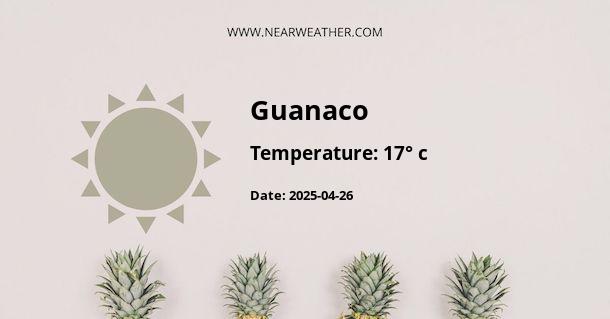Guanaco, AR: A Comprehensive Guide to Its Climate and Weather Year Round
Guanaco, located in the Tucumán province of Argentina, is a beautiful region known for its diverse landscapes and unique climate. Understanding the weather patterns and climate of Guanaco is essential for residents, visitors, and businesses. This comprehensive guide will provide detailed information about the climate and weather in Guanaco throughout the year.
Annual Climate Overview
Guanaco experiences a subtropical highland climate, characterized by mild temperatures and distinct wet and dry seasons. The region's climate is influenced by its elevation, topography, and proximity to the Andes mountains. The annual climate overview provides a glimpse into the typical weather patterns in Guanaco.
| Month | Average High (°C) | Average Low (°C) | Precipitation (mm) |
|---|---|---|---|
| January | 28 | 16 | 150 |
| February | 27 | 16 | 140 |
| March | 26 | 15 | 120 |
| April | 23 | 12 | 70 |
| May | 20 | 9 | 30 |
| June | 18 | 7 | 20 |
| July | 18 | 6 | 20 |
| August | 20 | 8 | 20 |
| September | 22 | 10 | 40 |
| October | 25 | 12 | 80 |
| November | 27 | 14 | 110 |
| December | 28 | 16 | 130 |
The above table illustrates the average high and low temperatures, as well as the precipitation levels in Guanaco across the twelve months of the year. It is evident that the region experiences a marked variation in both temperature and precipitation from month to month.
Seasonal Weather Patterns
Guanaco's weather is divided into distinct seasons, each with its own unique characteristics. Understanding the seasonal weather patterns is crucial for planning travel, outdoor activities, and agricultural operations in the region.
Summer (December - February)
During the summer months, Guanaco experiences warm temperatures with January being the hottest month. The average high temperature hovers around 28°C, while the average low is around 16°C. This period also sees relatively high precipitation, with an average of 150mm in January, making it the wettest month of the year.
Autumn (March - May)
Autumn in Guanaco brings milder temperatures, with the average high dropping to 26°C in March and further decreasing to 20°C in May. The precipitation levels also decrease significantly during this season, providing drier conditions for outdoor activities and agricultural practices.
Winter (June - August)
Winter in Guanaco is characterized by cool temperatures, with the average high hovering around 18°C. July is the coldest month, with an average low of 6°C. Precipitation remains relatively low during this season, creating cool and dry conditions in the region.
Spring (September - November)
Spring brings a gradual increase in temperatures, with the average high reaching 25°C in October. The region experiences moderate precipitation during this season, supporting the growth of vegetation and crops.
Extreme Weather Events
While Guanaco generally experiences mild and moderate weather conditions throughout the year, the region is susceptible to occasional extreme weather events. These events can have significant impacts on the local communities and infrastructure.
One of the primary extreme weather events in Guanaco is intense rainfall leading to flash floods, particularly during the summer months. These flash floods can pose risks to residents and disrupt transportation and communication networks in the region.
"The topography of Guanaco, with its proximity to the Andes, can enhance the impact of extreme weather events, particularly heavy rainfall and flooding. It is essential for the local authorities and residents to be prepared for such occurrences and have effective response measures in place." - Dr. Maria Lopez, Environmental Scientist
Climate Change and Adaptation
Like many regions across the globe, Guanaco is also facing the challenges posed by climate change. The impact of climate change on the region's weather patterns, water resources, and agricultural productivity necessitates adaptive measures and long-term planning.
Studies have indicated changes in precipitation patterns and increasing temperatures in Guanaco over the past few decades. These changes can have implications for water availability, crop yields, and ecosystem dynamics in the region.
"Adopting sustainable agricultural practices and water management strategies is crucial for building resilience against the effects of climate change in Guanaco. It is essential to promote climate-smart policies and technologies that can help mitigate the impact of changing weather patterns on the local communities." - Dr. Carlos Martinez, Climate Scientist
Conclusion
Guanaco's climate and weather exhibit distinct seasonal variations, influenced by its subtropical highland climate and geographic features. From the warm summers to the cool winters, understanding the weather patterns in Guanaco is essential for various aspects of life in the region, including agriculture, tourism, and urban planning. While the region faces challenges related to extreme weather events and climate change, proactive measures and sustainable practices can contribute to enhancing resilience and adaptation.
Whether you are a resident or a visitor, being informed about Guanaco's climate and weather year-round can enhance your experience and decision-making in this captivating region of Argentina.
A - Guanaco's Latitude is -35.713520 & Longitude is -61.647900.
A - Weather in Guanaco is 17° today.
A - Climate Conditions in Guanaco shows scattered clouds today.
A - Humidity in Guanaco is 93% today.
A - Wind speed in Guanaco is 23.62 km/h, flowing at 199° wind direction. today.
